The blueprint for security compliance has changed. You no longer need erratic tools or lengthy audits to prove your trustworthiness. If you're building in the cloud, automation has become your best ally.
That's why Sprinto has made headlines. It's a GRC platform tailored for fast-moving SaaS teams like yours.
In just a few years, the founder team has raised $31.8 million, signed over 1,000 customers, and increased revenue by 2.5 times. But a strong funding round isn't the same as strong execution.
So the real question is: what is Sprinto like once you log in? Does it hold up under pressure? Or are there better compliance platforms for learner teams?
This Sprinto review will guide you through the entire experience, including features, pricing, customer reviews, and a comparison with cost-effective alternatives, such as ComplyJet.
If you're evaluating tools for SOC 2, ISO 27001, or HIPAA compliance, this breakdown will help you make a clear, confident choice.
Now, let's align on the fundamentals first.
What is Sprinto?
You don't need to chase auditors with spreadsheets anymore. Tools like Sprinto give you a single system to manage your entire security program. It's built for teams that want to move fast without cutting corners.
Sprinto is a compliance automation platform. It helps you get audit-ready for SOC 2, ISO 27001, HIPAA, and GDPR. The platform connects to your tech stack, monitors controls, and collects audit evidence as you go.
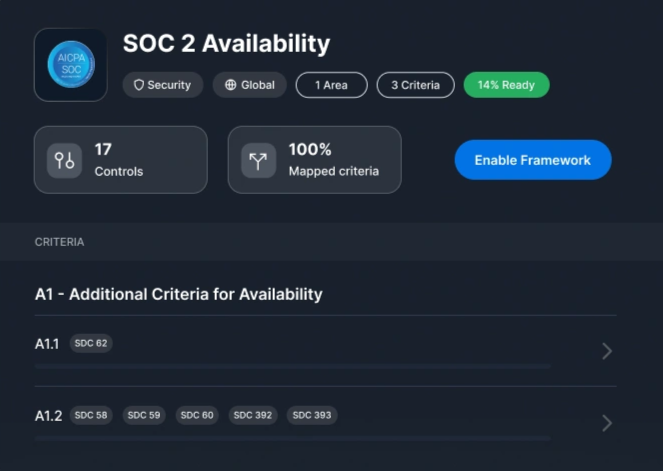
Sprinto's Core Purpose
It replaces manual GRC work with automation. It maps your systems to the right controls, monitors compliance gaps, and alerts you before any issues arise. It's like having a real-time checklist running in the background.
If you're involved in a SOC 2 or ISO 27001 project, you'll see how challenging that process can be. Sprinto software provides clear dashboards, pre-built policies, and workflows that eliminate the guesswork.
Supported Frameworks
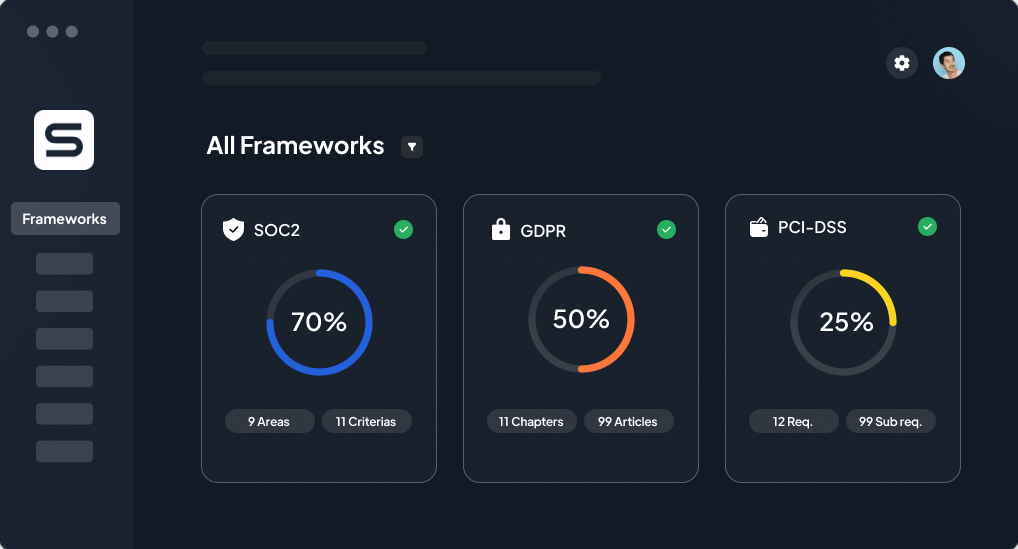
Sprinto supports over 30 frameworks. That includes:
- SOC 2 Type I and Type II
- ISO 27001
- HIPAA
- GDPR
- PCI-DSS
- NIST, FedRAMP, and CMMC 2.0
These all come preloaded. You can map shared controls across multiple certifications to save time and effort.
GRC Automation in Action
Sprinto's automation starts with integrations. It connects with your cloud, identity, HR, and code tools to pull compliance evidence. From there, it checks whether each control is passing.
If anything goes out of scope, you get an alert. No need to backtrack weeks later. And when audits begin, auditors can log in to their own Dashboard, view all the data, and work directly within the platform.

In the next section, we’ll see how the company itself grew into one of the top players in the GRC market.
Sprinto's Growth, Team, and Valuation
Most tools in this space came from consultants or legacy vendors. Sprinto is different. It was started by product builders who faced these problems firsthand and wanted to solve them cleanly.
Girish Redekar and Raghuveer Kancherla previously built Recruiterbox, a hiring platform. After selling it, they shifted focus to compliance. The platform was born from their own audit frustrations.
Funding and Revenue
Sprinto has raised over $31.8 million so far. The latest round, in 2024, was led by Accel. Earlier investors include Elevation Capital and Blume Ventures.
In FY24, Sprinto's revenue hit $5.7 million. That's up from ₹19.2 crore in FY23 to ₹48.1 crore. It's more than 2.5x year-over-year growth. This shows real traction across global markets.
Global Reach and Customer Base
The platform now serves over 1,000 customers across 75 countries. Many of these are early-stage SaaS companies. Others are mid-market firms scaling into new regions.
Customers choose Sprinto for speed. Some cut compliance time by 60 to 80 percent. Most complete SOC 2 in under 30 days.
If you want an even faster option, customers at ComplyJet report achieving audit-readiness in just 7 days for under $4,999 per year.
The Sprinto Team and Culture
As of 2025, Sprinto employs around 200 people. The team is fully remote and spread across time zones. Roles are split between engineering, customer support, and product.
Sprinto's hiring reflects its product DNA. They move fast, ship often, and prioritise user feedback. You'll see this mindset baked into their product updates and customer playbooks.

The product and the company have grown fast, but not blindly.
Next, we’ll explore what it actually feels like to use the platform, starting with its most important features.
Full Breakdown of Sprinto Features
If you've dealt with security audits before, you're familiar with the challenges that arise. The platform tries to change that. It brings every part of your compliance workflow into one place.
You log in once and get a complete view of what's done, what's pending, and what needs fixing. The Sprinto dashboard is where everything starts.

Compliance Dashboard and Automation
The Sprinto dashboard shows your live audit status. Every control, document, and integration is tracked in real time. It updates as your systems change, so nothing gets stale.
You can customize the view to focus on key frameworks, such as SOC 2 or ISO 27001. Each section has clear pass/fail markers and action items. It keeps your team aligned.

It automates checks for every major security control. When something breaks, it sends alerts and opens tasks. You never have to wait until audit week to find out what's wrong.
Zones and Auditor Access
Zones let you manage compliance by entity. If you have multiple products or regions, each gets its own space. You still manage everything from a single dashboard.

Auditors get their own portal. They can view evidence, download files, and leave comments. You don't need to email spreadsheets back and forth.
The auditor dashboard also tracks questions and clarifications.
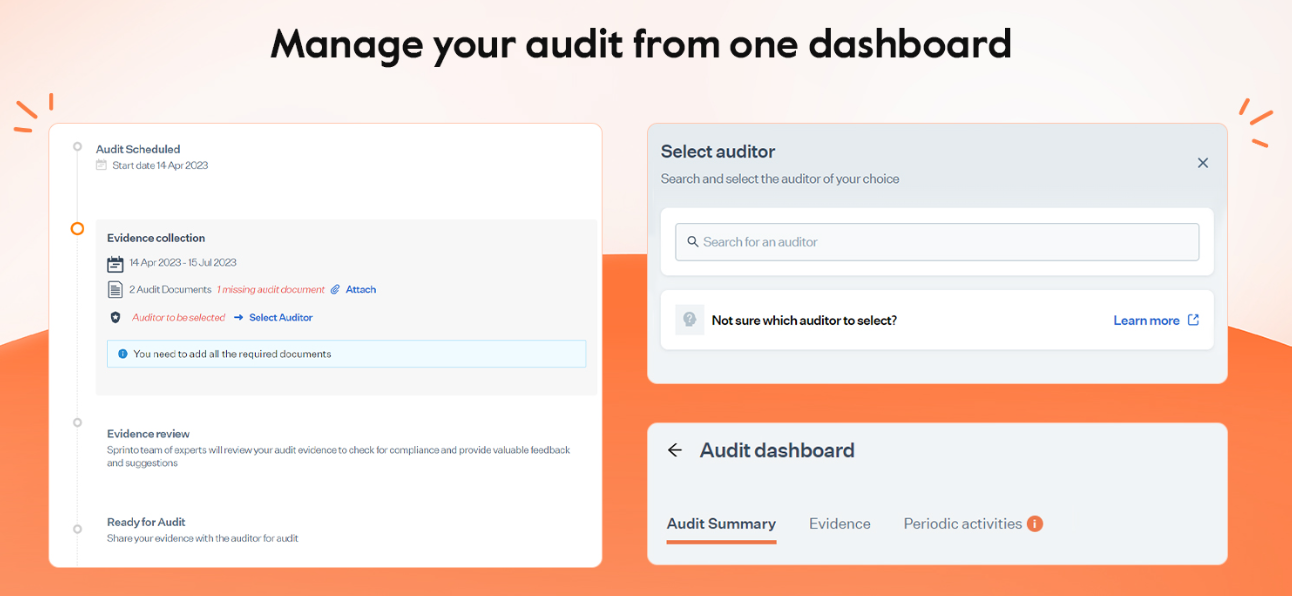
It reduces the number of days spent on back-and-forth communication and helps you close audits more quickly.
Risk Management and Security
Sprinto includes a built-in risk module. You can assign severity levels, add remediation plans, and track updates. It helps you show auditors that your risks are managed and monitored.
Security controls are tested automatically. If a user account stays active after termination, Sprinto flags it. If MFA is missing, it notifies you.

This is part of why Sprinto handles data privacy well. It documents controls and monitors them in real-time. This adds confidence when working toward GDPR or HIPAA compliance.
Trust Centre and Training
Sprinto's Trust Centre is a customer-facing portal. You can publish your security posture, reports, and certifications. It helps close deals without NDAs or long questionnaires.

The portal can be gated with approvals or open to anyone. You control who sees what, and for how long. Each view is logged for audit records.
You also get built-in training modules. Assign courses to your team, track completion, and meet the audit requirement for employee awareness.
Sprinto covers every core area you'd expect in a GRC tool.
Now, let's examine how it integrates with your existing stack, which features over 200 native integrations.
Sprinto Integrations & Automation Ecosystem
Most compliance platforms promise automation. Few actually deliver it. Sprinto makes that promise real by integrating directly with your cloud stack, tools, and workflows.
You connect it once, and it starts pulling evidence, checking controls, and flagging issues across systems without adding new overhead to your team.
Integration Categories
Sprinto supports 200+ integrations across major tool categories:
- Cloud Infrastructure: AWS, Azure, Google Cloud
- Identity Providers (IDPs):Okta, Azure AD, Google Workspace
- CI/CD Pipelines: GitHub, GitLab, CircleCI, Bitbucket
- HR & PeopleOps: Rippling, BambooHR, Workday, Gusto
- Ticketing Tools: Jira, ServiceNow, Zendesk
- Communication: Slack, Microsoft Teams, email clients
This coverage means you don't need to manually upload logs or screenshots. It syncs with these tools and maps their outputs to your compliance controls.
Automated Evidence and Change Monitoring
Once connected, Sprinto automatically pulls audit evidence. It knows what counts and where to find it. Things like terminated user logs, code pushes, and policy acknowledgments update in real-time.
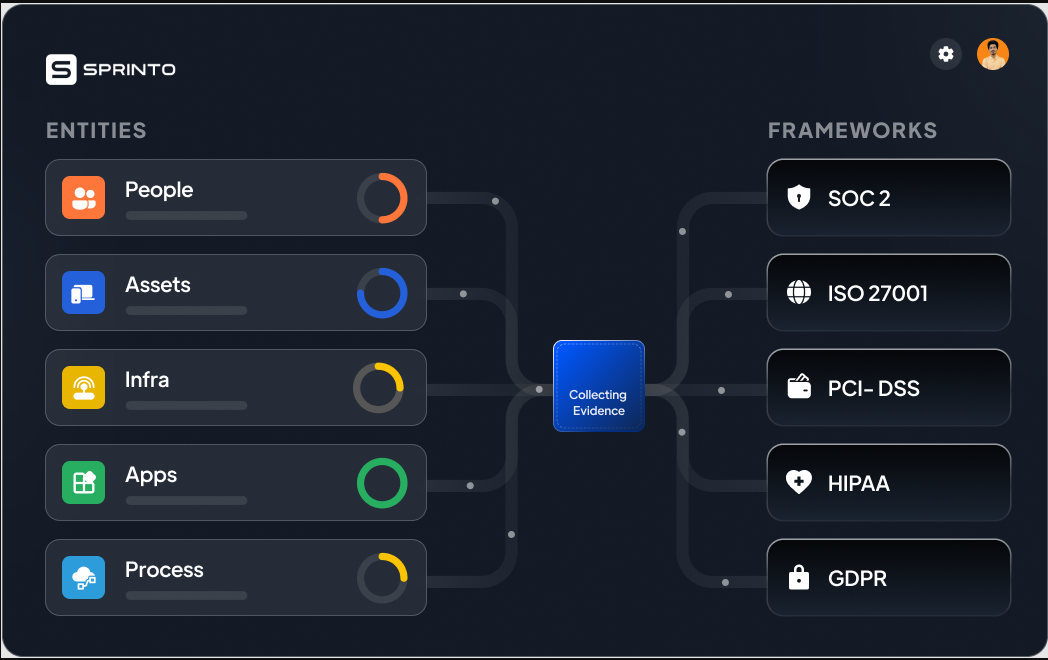
Change management gets tracked, too. If a developer makes a risky commit or a user is granted admin rights, the system flags it. That feeds into your risk register automatically.
It also monitors control health. If a required control stops working, it notifies the right person. You spend less time checking boxes and more time fixing what matters.
Developer-First Design
Sprinto is built for real teams. It understands how dev environments work. GitHub, GitLab, and CI/CD tools plug in cleanly. You can map control logic to repo-level actions or even tie access reviews to GitHub roles.
If you're building fast, you need compliance that can keep up. This system doesn't interrupt the flow; instead, it fits into it.
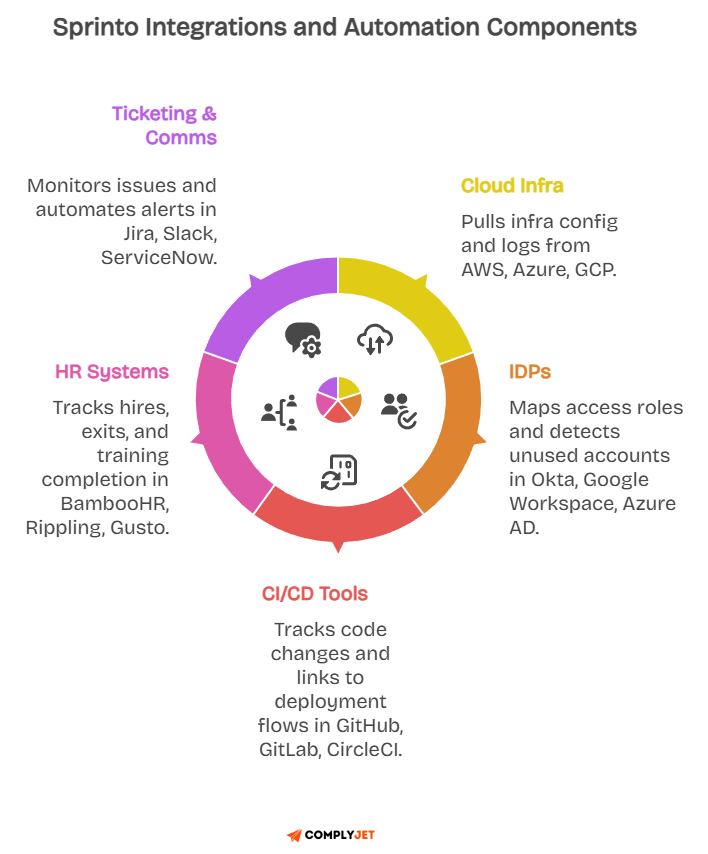
Sprinto's ecosystem helps you keep your systems and your audits in sync.
Next, we'll examine the actual cost of this level of coverage and compare it to tools like Drata or ComplyJet.
How Much Does Sprinto Cost?
Sprinto pricing follows a usage-based model. There's no per-seat cost. You pay based on your company's size, the number of frameworks, and the complexity of your setup.
There are four plan levels. Each one adds more features and support.

Here's how the tiers break down:
- Starter: Built for early-stage teams. Includes basic integrations (AWS, GSuite), policy templates, evidence tracking, and team training. Ideal if you're tackling SOC 2 or ISO 27001 for the first time.
- Professional: Adds support for custom controls, advanced policy mapping, and better internal workflows. Fits growing teams working with hybrid environments or managing multiple frameworks.
- Advanced: Enables the Zones feature to manage compliance across entities or products. Supports multiple standards (SOC 2, ISO 27001, HIPAA, GDPR) with shared evidence and team-level permissions.
- Enterprise: Designed for scale. Offers premium support, private cloud deployment, API access, and deep integrations with tools like ServiceNow, Snowflake, and Jira. Suitable for heavily regulated orgs.
Each plan includes unlimited users and frameworks. Pricing scales with company size and framework requirements, rather than the number of users.
Real-World Pricing Examples
If you're conducting a SOC 2 audit for a 50-person SaaS team, expect to pay around $7,000 to $10,000 per year on Sprinto. That includes automation, support, and auditor access.
Adding ISO 27001 or HIPAA will increase the cost. But you don't need to double your budget. Shared controls mean you reuse work across frameworks.
Companies that operate across multiple frameworks typically earn between $9,000 & $15,000 per year. Larger setups can extend beyond that, depending on the complexity of the infrastructure and support needs.
Comparing Drata vs Sprinto vs ComplyJet
Drata pricing starts at approximately $15,000 per year and can exceed $50,000 for multi-framework setups. Vanta follows a similar range. Sprinto comes in at a lower price, especially for smaller teams.
ComplyJet pricing, by comparison, starts at $4,999 per year and bundles audit coordination in the same stack.
If you're an early-stage company or seeking a faster path to audit readiness, compare both options before making a decision.
Value for Small Businesses
Sprinto offers solid value for growing companies. But if you're a team of three or five, it might be overkill unless you're managing multiple frameworks.
Read: Sprinto Pricing Plans 2025: Real Costs, ROI & Negotiation Tips
That's where alternatives like ComplyJet shine. You get fast setup, AI policy generation, and bundled auditor packages without the heavier price tag.
Sprinto pricing overview:
Sprinto gives you flexibility and automation at a mid-market price. In the next section, we'll compare its strengths and gaps against Drata, Scrut, and other tools in the space.
Sprinto vs. Competitors
You've seen how the platform works. Now it's time to compare. If you're evaluating compliance platforms, you've likely encountered names like Drata, Scrut, and ComplyJet in your search results.
Each tool serves the same goal of automating your path to compliance. However, their strengths, pricing, and UX vary significantly. What works for a 500-person enterprise may not work for a lean 10-person SaaS.
Sprinto vs. Drata
Drata is a big name in the GRC space. It's known for a strong security posture and a polished design.

Sprinto matches it in automation but has broader integration depth and more control over Zones.
Drata works well for compliance teams that want a clear workflow and built-in security checks. But Drata pricing (~$15,000/year) makes it tough for early-stage teams.
Sprinto comes in at a lower price, ranging from $4,000 to $5,000 for small setups. If you're trying to achieve SOC 2 compliance without draining your budget, it may be the more cost-effective option.
Sprinto vs. Scrut
Scrut positions itself as a simpler GRC platform. It supports core frameworks like SOC 2 and ISO 27001, but its integration library is smaller, and some automation steps still require manual intervention.

Sprinto leads when your team needs deeper control mapping, more frameworks, and multi-entity scopes. Scrut works well when you want basic automation without heavy setup.
If you're planning to scale into more frameworks later, Sprinto's common control mapping gives you an edge. You don't have to rebuild every time you add PCI-DSS or HIPAA.
Sprinto vs. ComplyJet
ComplyJet is designed for lean, cloud-native teams. It offers full compliance automation, AI-powered policy drafting, and direct coordination with auditors. It's also one of the few platforms with transparent pricing under $4,999/year.
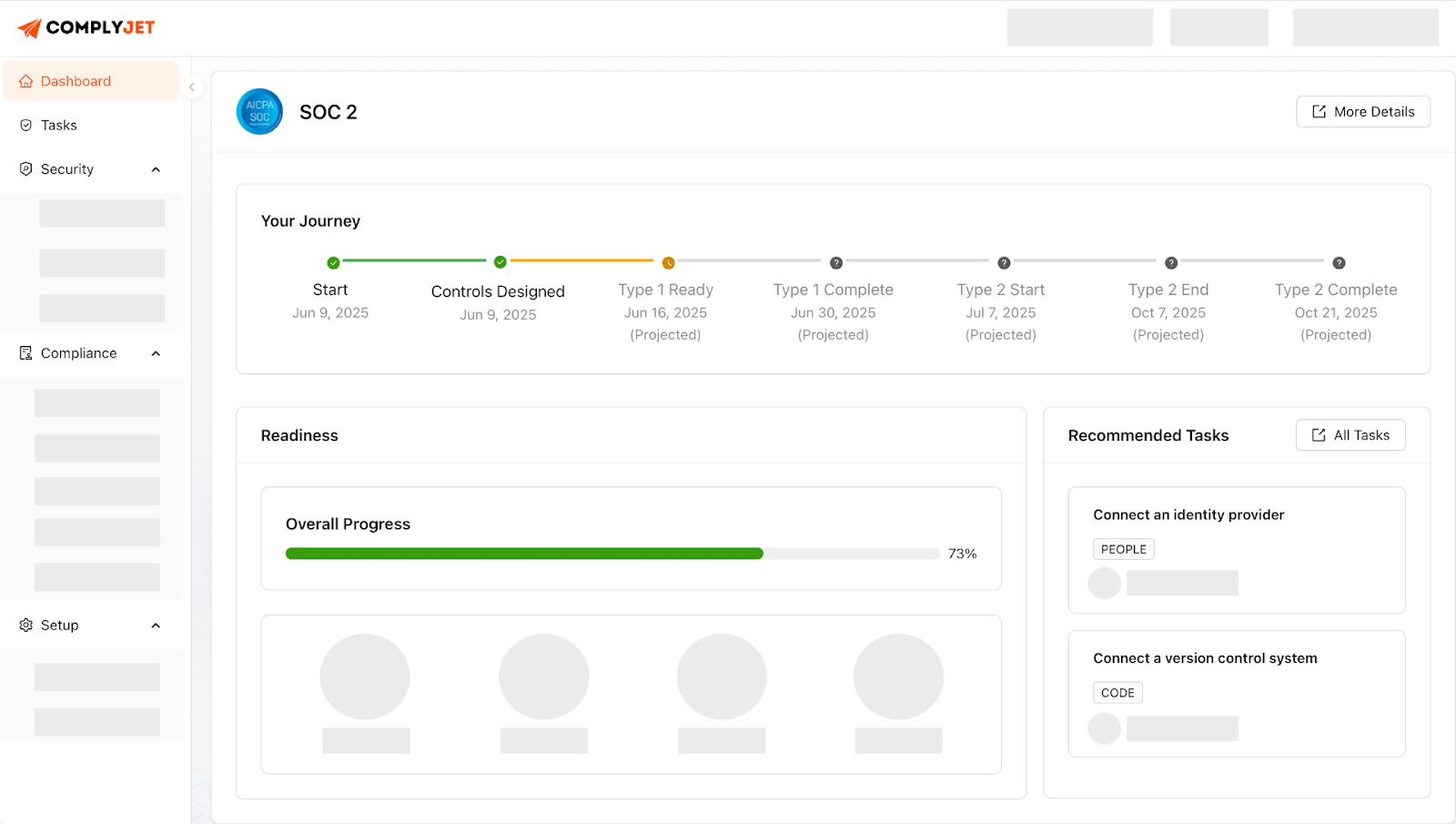
Sprinto shines when you need deep customisation, advanced Zones, or managing complex infra. However, if you require fast audit-readiness without feature bloat, ComplyJet is a lighter and faster option.
You also get bundled access to pre-vetted auditors, which saves weeks of audit coordination. For many early-stage SaaS companies, this makes all the difference.
Sprinto vs top GRC tools
The platform works best when you need scale and control. But if you're looking for speed, clarity, and lower cost, ComplyJet may be the smarter bet.
Let's now see what real users say about Sprinto on G2 and Reddit.
Real User Feedback: Pros and Cons
Marketing sites will tell you everything works. However, real users often highlight the edges, such as what breaks, what shines, and what helps teams meet audit deadlines without burnout.
Sprinto holds a 4.8/5 rating on G2. That's based on over 1,400 verified reviews. Most comments focus on the ease of setup, helpful support, and how automation saves teams weeks of preparation.

Capterra rates the platform a solid 4.7/5 and Reddit users collectively find Sprinto pricing similar to market players like Vanta & Drata and far less room for customisation.

Pros
Many users call Sprinto a "compliance game changer." The Dashboard gives clear visibility into progress. The integrations pull evidence automatically. Tasks are easy to assign and track.

Support gets high praise, too. Sprinto's team is often cited as fast, knowledgeable, and willing to jump in on short notice. For small teams, this saves a lot of back-and-forth.
The automation significantly reduces the time required for audit preparation. Companies typically report completing SOC 2 Type I readiness in 25–30 days, with minimal manual work required.
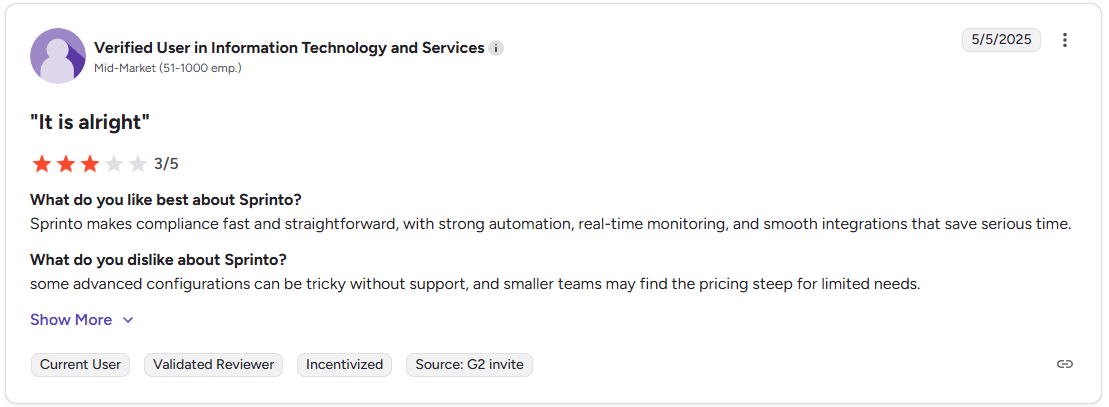
Cons
The learning curve can be sharp. First-time users sometimes feel overwhelmed by the number of features. There's a lot packed into the Dashboard.

Some users mention small UX bugs or missing customisation options. Others note that pricing can feel high for very small companies or pre-seed teams.
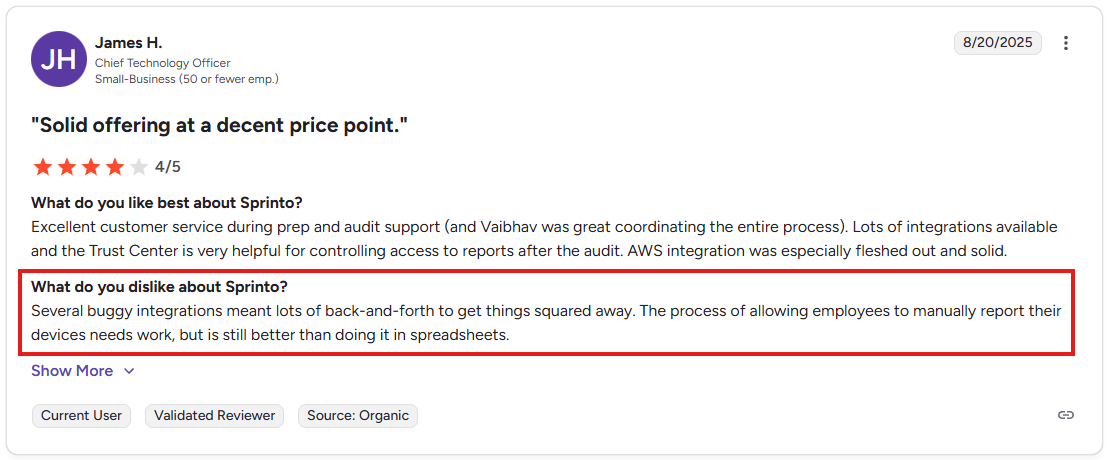
Users also report limitations in some of the features.

Reddit threads echo the same themes. Users ask, "What does Sprinto do on Reddit?" and often hear back: "It works, but the cost can be steep unless you're scaling fast."
Where ComplyJet Fits In
This is where ComplyJet fills a gap. It's cleaner, simpler, and faster to onboard.
Pricing fits earlier-stage teams better. You still get AI-powered policies, 200+ integrations, and built-in auditor access.
The platform is great once you hit product-market fit. However, if you need audit-readiness without overpaying or overbuilding, ComplyJet is worth considering, especially for SOC 2 or ISO 27001 compliance.
Sprinto user feedback themes
User stories make things real.
In the next section, we'll walk through Sprinto case studies to see how teams use it day-to-day, and what results they actually get.
Sprinto Security Standards
When you're preparing for audits, trust becomes a product feature. Your customers need proof that their data is handled with care and respect. Sprinto gives you the tools to show that clearly and confidently.
You don't need to bolt security onto compliance. Sprinto was designed to integrate both through certified practices, built-in protections, and audit-ready controls from day one.
SOC 2 Type II and Core Certifications
Sprinto is SOC 2 Type II certified. That means their internal systems are regularly tested for security, availability, and integrity. It's the same bar that many of your customers require you to meet.
If you're working toward ISO 27001, HIPAA, or GDPR compliance, Sprinto's own compliance provides a helpful benchmark. They've built the platform using the same frameworks you'll be following.
This means controls inside the product reflect real-world audit expectations. The language, mappings, and workflows feel familiar if you've been through certifications before.
Built-in Security Features
The platform includes modern protections as default settings. That starts with multi-factor authentication (MFA) for every account. You also get role-based access control (RBAC), so team permissions stay clean and secure.
Every action in the platform is logged. Audit trails show who changed what and when. Files are encrypted at rest and in transit. These controls reduce the actual risk.
If your organisation spans countries, Sprinto supports data residency and storage compliance. This matters if you're working with European clients under GDPR.
Trust Centre and Privacy Controls
The Trust Centre helps you showcase your accomplishments without oversharing. You can make security documentation public or gate it with NDA flows. Every file view is tracked for record-keeping.
The platform also gives you fine-grained control over document expiry, access levels, and download permissions. It's privacy and transparency working side by side.
You can create a branded page that includes SOC 2 reports, pen test results, or security policies. Buyers get answers fast. Your team avoids repetitive questionnaires.

Sprinto doesn't just help you pass audits. It bakes security into your daily workflows.
In the next section, we'll cover how the platform utilizes this automation to drive faster and cheaper certifications across frameworks.
When to Use Sprinto?
You now have a sense of how Sprinto works. The next step is to determine if it aligns with your stage and workflow. Every team has a different mix of needs, tools, and deadlines. The right choice depends on that mix.
Sprinto can be a strong fit when your compliance scope grows fast. But it can feel heavy for early teams.
This section will help you identify where the Sprinto software excels and where an alternative like ComplyJet may be a better fit.
When Sprinto Fits Best
Sprinto works well when you handle multiple frameworks. If you plan to add ISO 27001 or HIPAA right after SOC 2, the common control system helps you reuse work across all audits.
It also helps fast-growth teams stay organised. The Dashboard consolidates all controls and tasks in one place. You get fewer gaps as your team grows and your infrastructure changes.
It seamlessly fits teams that want deeper control and coverage. Its Zones feature supports complex setups with many products or regions. This is particularly helpful when expanding into new markets.
When ComplyJet Makes More Sense
ComplyJet is better when you want simple and clear workflows. It cuts setup time with AI-based policy drafts and smart control mapping. You get clean progress tracking without extra layers.
If cost matters, ComplyJet fits early teams better. It helps you start SOC 2 or ISO 27001 at a much lower price. You also get audit coordination built into the platform.
ComplyJet works well for founder-led teams to get audit-ready in just a week. You can get guidance, automation, and a full Trust Center without managing a heavy system.
Feature Tradeoffs to Consider
The platform offers strong multi-entity support and large-scale automation. But it can feel complex when your company is small. ComplyJet focuses on clarity, AI workflows, and speed to audit.
You also get more direct support on ComplyJet. Teams use it to get audit-ready in days instead of months. If your compliance needs are narrow and urgent, the lighter tool is easier to handle.
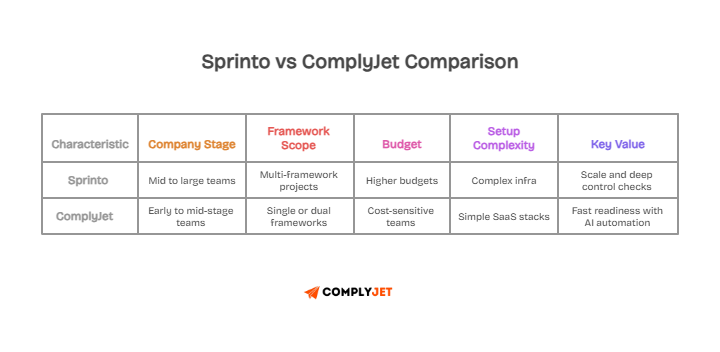
Sprinto provides you with scale and coverage as your compliance scope expands. If you want speed, cost control, and a lighter system, ComplyJet is a more straightforward option.
Frequently Asked Questions About Sprinto
What are customer reviews of Sprinto?
Sprinto reviews on G2 consistently highlight strong automation, audit readiness, and responsive support. With a 4.8/5 average rating, users say Sprinto software saves them weeks of effort during SOC 2 and ISO 27001 compliance audits.
Reviewers often mention that the Sprinto dashboard provides real-time visibility and that their support team helps simplify challenging certification milestones.
Is Sprinto an Indian company?
Yes, Sprinto is an Indian company with a global presence. It was founded in 2020 by Girish Redekar and Raghuveer Kancherla, the same duo behind Recruiterbox.
While headquartered in the U.S., most of the engineering and product teams operate remotely from India, supporting compliance automation for companies worldwide.
How much does Sprinto cost?
Sprinto pricing starts at around $7,000 to $10,000 per year for single-framework implementations, such as SOC 2 Type 1.
As you add frameworks like HIPAA or ISO 27001, the Sprinto price scales based on company size, cloud complexity, and risk scope.
For fast-growing teams, it's more affordable than Drata or Vanta, though early-stage startups may prefer a lower-cost ComplyJet alternative.
What does Sprinto do?
Sprinto is a GRC tool that automates compliance workflows for SaaS and tech-driven businesses. It integrates with your systems, runs control checks, gathers evidence, and helps you meet certifications like SOC 2, ISO 27001, HIPAA, and GDPR.
The Sprinto Trust Centre also lets you share your security posture with customers.
What skills are needed for Sprinto careers?
Sprinto careers span engineering, product, compliance, and customer success. For technical roles, experience in backend systems, cloud infrastructure, or security tooling is preferred.
On the compliance side, understanding of SOC 2 or ISO 27001 frameworks is valuable. Across roles, the platform looks for ownership, async communication, and startup experience.
Does Sprinto offer remote positions?
Yes, Sprinto offers remote-first roles across functions. Most employees work remotely across India, Europe, and the U.S. Their hiring model supports global collaboration, and many of their job listings specify full-remote eligibility.
Sprinto careers emphasise flexible work aligned with fast-paced startup growth.
Is Sprinto a good company?
Sprinto is considered a strong company in the compliance space. With $31.8 million in total Funding, over 1,000 customers, and rapid revenue growth, it has proven traction.
On G2, Sprinto reviews praise its platform automation and team responsiveness. It's seen as one of the leading SOC 2 and ISO 27001 automation tools globally.
What is the average salary in Sprinto?
The average salary varies by role and location.
Based on current data, engineering roles in India range from ₹20 to ₹ 40 LPA, while U.S.-based roles in customer success and partnerships can range from $ 80,000 to $ 120,000.
Sprinto compensation includes equity for many key roles.
What is the difference between Sprinto and Scrut?
The difference between the both lies in the depth of automation, coverage of integration, and scalability.
Sprinto supports over 30 frameworks, includes Zones for multi-entity management, and offers more than 200 integrations.
Scrut supports fewer frameworks and is more suitable for smaller or single-entity setups.
What is it like to work at Sprinto?
Working there means joining a high-ownership, fast-paced team that solves complex compliance problems. Employees report a good remote culture, challenging projects, and a clear product vision.
The company values independence and ships product improvements often, in close feedback loops with customers.
What are the disadvantages of Sprinto?
While the Sprinto software has strong automation, it can feel overwhelming to smaller teams due to its depth. Some users report a learning curve with the Dashboard and pricing that's better suited to mid-sized companies.
What is Dr Sprinto?
Dr Sprinto is a feature within Sprinto that acts like a lightweight device monitoring and endpoint management tool. It helps track compliance across employee machines by checking device encryption, antivirus status, and OS compliance.
It's similar to what traditional MDM tools offer but built for compliance use cases.
What are some success stories using Sprinto?
Sprinto customer success stories include Fyle achieving SOC 2 compliance in under 30 days, Apty completing ISO 27001 certification in two weeks, and NitroPack achieving 98% PCI-DSS control health within a month.
These teams cut audit prep time by 60%–80% using Sprinto compliance workflows and integrations.
Final Takeaway
Sprinto is a strong compliance tool. It provides automation, clear control mapping, and support across multiple frameworks. It works best when you need to manage a big scope with many moving parts.
If you're an early-stage SaaS team, Sprinto may feel heavy. In that case, ComplyJet is a clean and fast alternative. It helps you become audit-ready in days, and it fits tighter budgets.
The simple view is this:
- Sprinto helps you scale complex compliance programs.
- ComplyJet helps you move faster with clear AI workflows and lower costs.
For a smoother start, you can try ComplyJet for free or schedule a brief walkthrough to make an informed decision.



